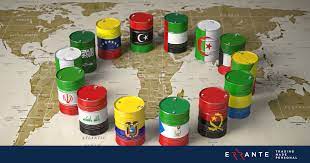OPEC+ reversed on Monday this month’s increase in oil production targets and cut the group’s collective quota by 100,000 barrels per day (bpd) for the month of October.
While the move is totally negligible in terms of actual supply to the market, considering not only the slight change in the overall target but also the massive underperformance from the producer group in the region of 2.9 million bpd below quota, the decisions of OPEC+ from Monday sent a strong message to the oil market that the group is ready to meet at any time and decide on any cuts it deems appropriate to “stabilize” oil prices.
It’s a message to the market that analysts are largely interpreting as the resolve of the alliance and its de facto leader, Saudi Arabia, to continue intervening on the market and not let prices fall too low from current levels.
The OPEC+ meeting on Monday endorsed a decision to cut the collective oil production target by 100,000 bpd for October, despite Russia reportedly resisting such a move. In another super-short meeting, the energy ministers of the OPEC+ production pact agreed to return the targeted production levels to the August quotas, saying that last month’s increase was intended only for September.
But more importantly, OPEC+ decided that it could call a meeting at any time to discuss other actions. The meeting, OPEC said, decided to “Request the Chairman to consider calling for an OPEC and non-OPEC Ministerial Meeting anytime to address market developments, if necessary.”
By giving the alliance’s chairman, Saudi Energy Minister Prince Abdulaziz bin Salman, the power to call a meeting at any time if needed, OPEC+ sent a strong message to the oil market: cuts could come at a short notice, “in any form”, which could mean that unilateral cuts may not be off the table, either.
While the token cut for October doesn’t change anything in fundamental supply/demand balances, OPEC+’s readiness to intervene whenever it deems necessary suggests that Saudi Arabia and other influential OPEC+ members believe that oil prices have seen enough sell-offs in recent months already.
“The action from OPEC+ does seem to confirm that the floor for Brent is not too far below US$90/bbl. And while little changes in the supply/demand balance, it does not send a great message to the US administration, which has been putting pressure on OPEC for much of the year to increase output more aggressively,” Warren Patterson, Head of Commodities Strategy at ING, commented on the OPEC+ meeting’s outcome. The U.S. Administration, for its part, commented on the latest OPEC+ decision with White House press secretary Karine Jean-Pierre saying “The President has been clear that energy supply should meet demand to support economic growth and lower prices for American consumers and consumers around the world,” as carried by AP.
“President Biden is determined to continue to take every step necessary to shore up energy supplies and lower energy prices,” the White House added.
But Saudi Arabia thinks of market “stability” – or in OPEC+ parlance higher oil prices – with its most recent messages to the market.
Last month, Prince Abdulaziz bin Salman said that OPEC+ was ready to cut production at any time in any form if it believes it would bring stability to the “schizophrenic” oil market.
After the 100,000-bpd cut was agreed upon on Monday, the energy minister of the world’s top crude oil exporter told Bloomberg in an interview “This decision is an expression of will that we will use all of the tools in our kit.”
“The simple tweak shows that we will be attentive, preemptive and pro-active in terms of supporting the stability and the efficient functioning of the market to the benefit of market participants and the industry,” Prince Abdulaziz bin Salman said.
The small cut in October quotas is “intended to send the signal that OPEC+ is back into a price-watch mode,” Bill Farren-Price, head of global oil and gas macro research at Enverus, told Bloomberg.
According to Jason Bordoff, an energy and climate policy expert at Columbia University: “Oil (and pump) prices have been falling. 100kbd may seem negligible but the message from today’s cut is clear: OPEC+ thinks they’ve fallen enough.”
An OPEC source told Reuters after Monday’s OPEC+ meeting that “The price movements up and down is raising concern,” while another source at a Gulf country said that “The members have trusted that the chairman can intervene whenever necessary to bring more stability and this can be beyond October until the end of the (OPEC+) agreement.”
What’s Next?
OPEC+ will seek stability and keep its thinly-stretched spare capacity untouched amid heightened uncertainty in both supply and demand in the coming months.
In supply, it’s not certain how the planned price cap on Russian oil would impact markets, especially if Russia follows through ons threat to stop exporting its oil to importers that will have joined that cap mechanism. Then, there is the possibility of a revival of the Iranian nuclear deal, although the latest developments point to a move “backwards” in the indirect EU-mediated U.S.-Iran talks on a final draft of a possible agreement.
On the demand front, economic slowdown in major economies, including China and the United States, could dent oil demand growth. But an acute shortage of natural gas in Europe and sky-high gas prices in both Europe and Asia could prompt more gas-to-oil switching as winter approaches.

 Iran Energy News Oil, Gas, Petrochemical and Energy Field Specialized Channel
Iran Energy News Oil, Gas, Petrochemical and Energy Field Specialized Channel



